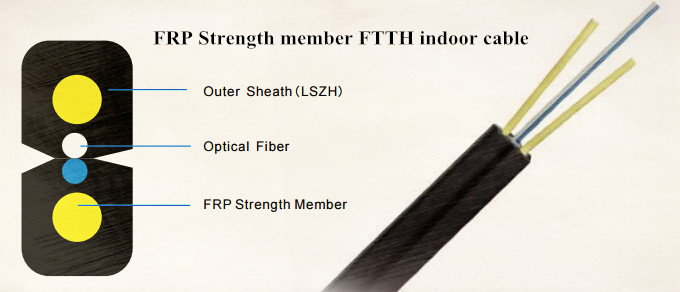FTTH has been widely deployed as the high demand for bandwidth of video, audio and data signals transmission. More and more FTTH networks have been and will be installed in subscribers’ houses due to growing requirements for them and enhancements on their technologies. A variety kind of FTTH cables are accordingly designed including in-duct cables, direct-buried cables, drop cables and indoor cables, etc. FTTH indoor cables are mostly difficult to be installed among those cables for the complex indoor environment. Today, this article will introduce FTTH indoor cables in details.
FTTH indoor cable is used inside a building or house to connect the FTTH user end equipment. Its fibre count typically is 1, 2 or 4 optical strands commonly combined with two non-metal enhanced FRP/Metal/KFRP which can provide sufficient tensile strength and good resistance to lateral crushing to protect the fibre inside. In addition, its outer sheath is universally consist with LSZH material with good flame-retardance in white or black. Its simple convenient structure makes it perfect for indoor cabling.
FTTH indoor cable is usually installed along the walls, behind moldings, around corners or through ceilings. The local environment including building styles, existing ducts, owners’ personal requirements and life security control decides the specific operation like the length and bend amplitude of the indoor cable. And nowadays the cables need to have both mechanical strength and flexible installation capacity for smaller subscribers’ houses as the rapid development of FTTH. The bend-optimised cables are prevailing in FTTH indoor installation for its great bend performance around the sharp edges and corners in smaller houses. The following pictures show the installation of FTTH indoor cable.
Due to its simple structure and installation requirements, FTTH indoor cable is designed to have size and quality advantages over a common indoor fibre. It is small diametre, soft and bendable, easy to deploy and maintenance, allowing a reduction in the physical size of connection equipment such as splice closures and termination boxes. And special FTTH indoor cable is even able to be thunder-proof, anti-rodent or waterproof for life security. With its extraordinary advantages, FTTH indoor cable is widely applied, pushing the development of FTTH as well as guaranteeing people’s life securities as much as possible.
- Access network, fibre to the home
- Used end users directly cabling
- Indoor cabling and distribution
For more information about FTTH indoor cables, please visit www.fs.com.
